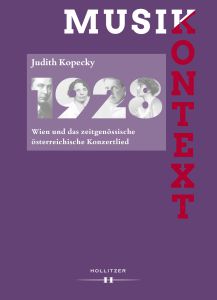Judith Kopecky, 1928. Wien und das zeitgenössische österreichische Konzertlied, Hollitzer Verlag, Wien, 2023

Mit akribischer Genauigkeit hat Judith Kopecky im Rahmen ihres Dissertationsprojekts das Musikleben Wiens im Jahre 1928 untersucht. Der Fokus ihrer Forschung liegt dabei auf dem zeitgenössischen österreichischen Konzertlied – wobei die Autorin unter diesem Begriff nicht nur Werke für Gesang und Klavier, sondern auch Lieder mit instrumentaler Ensemble- oder Orchesterbegleitung versteht. Kopecky hat sich entschlossen, neben den Kompositionen selbst auch deren „Produktions-, Aneignungs- und Verbreitungsbedingungen“ – also das gesamte musikkulturelle und kulturbetriebliche Umfeld – forscherisch miteinzubeziehen.
Spannend erscheint, dass die Autorin nicht etwa eine diachrone Gesamtschau des Kunstliedes in der Ersten Republik, sondern eine synchrone, mit enormer Liebe zum Detail ausgestaltete Dokumentation eines einzigen Jahres innerhalb dieses Zeitraums vorlegt. Warum gerade 1928? Wir erfahren, dass hier mehrere Faktoren von der Quellenlage über den 100. Todestag Franz Schuberts, der in diesem Jahr gefeiert wurde, bis zur Rückkehr Ernst Kreneks nach Österreich eine Rolle gespielt haben. Politisch markiert das Jahr 1928 freilich genau die „Halbzeit“ der Ersten Republik zwischen der Abdankung Kaiser Karls 1918 und dem Anschluss Österreichs an das nationalsozialistische Deutschland 1938.
Im Kapitel Klangwelten beschreibt die Autorin, in welchen Settings – wie zum Beispiel Liederabende, Kammermusikabende, Orchesterkonzerte, aber auch Radiosendungen – es zu den Aufführungen kam. Unter Spielräume werden die Veranstalter_innen, aber auch die ausübenden Musiker_innen benannt. Im Abschnitt Schreibzonen wird die einschlägige kompositorische Tätigkeit dieser Zeit vorgestellt – ohne dabei Komponistinnen wie Lili Hutterstrasser-Scheidl zu vergessen. In den Gedankensphären wird die einschlägige Musikkritik in Printmedien sowie im Radio thematisiert. Eine im Anhang platzierte detaillierte Auflistung aller 1928 stattgefundenen öffentlichen Darbietungen zeitgenössischer österreichischer Konzertlieder rundet das Werk ab.
Der Autorin ist – trotz oder vielleicht gerade wegen ihrer Fokussierung auf das zeitgenössische österreichische Lied und der Beschränkung auf ein einziges Jahr – ein veritabler Beitrag zum Verständnis des Musiklebens der österreichischen Zwischenkriegszeit insgesamt gelungen.

